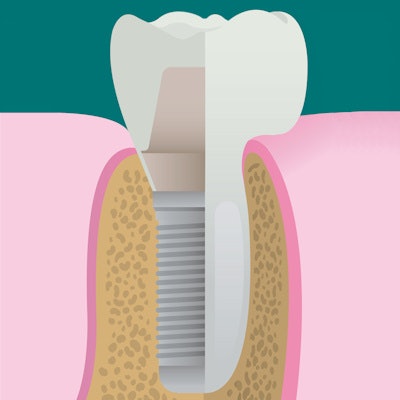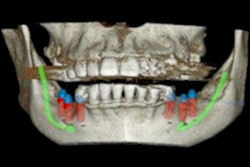
Dental implant use has grown substantially since 1999, and the prevalence among those missing at least one tooth could reach as high as 23% in 2026 in the U.S., according to a new study. At the same time, access is still low and remains greater among certain groups, the authors noted.
The researchers examined data from 1999 through 2016 and determined that prevalence among adults missing at least one tooth rose from 0.7% to 5.7%. However, prevalence varied by age, type or lack of dental insurance, and education level and was consistently higher among more advantaged groups.
"Further efforts should be made to better understand the factors associated with this disparity and to ensure that a larger portion of the population has access to dental implant treatment," wrote the authors, led by Hawazin Elani, PhD, an instructor in restorative dentistry and biomaterials sciences at Harvard School of Dental Medicine in Boston (Journal of Dental Research, August 3, 2018).
Unequal access
Not much is known about implant prevalence in the U.S. aside from the general impression that implant use has been increasing and market research demonstrating that the number of implants used has gone up, the authors noted. They conducted the study to improve understanding about the prevalence of implants in the U.S. and any disparities in access.
They analyzed data from the annual National Health and Nutrition Examination Survey (NHANES) for seven of the surveys conducted from 1999 through 2016. NHANES includes interviews and physical exams for a sample of the civilian noninstitutionalized population in the U.S.
The researchers also projected implant prevalence through 2026 under four different assumptions about the increasing prevalence: that it would stop, slow, continue at the same pace, or continue at an increased pace.
In the current study, the investigators included survey participants missing at least one permanent tooth (n = 32,758) in their analysis of implant prevalence, which they calculated based on the number of patients who had at least one implant (n = 618).
Compared with those missing at least one tooth without any implants, those with at least one implant were more likely to be women, white, have completed more than a high school education, and have public or private health insurance (95% versus 83%) (see table below).
| Population-weighted proportions of demographic characteristics of adults missing teeth in NHANES 1999 to 2016 | ||
| Variable | Without implants (n = 32,140) |
With implants (n = 618) |
| Female | 52.3% | 55.9% |
| Age: 55 to 64 | 15.1% | 23.8% |
| Age: 65 to 74 | 10.2% | 28.1% |
| Education: High school or less | 40.9% | 23.5% |
| Education: More than high school | 59.1% | 76.5% |
| Race: White | 69.6% | 79.6% |
| Race: Nonwhite | 30.4% | 20.4% |
| No health insurance | 17.5% | 5.2% |
| Private health insurance | 56.2% | 53.9% |
| Public health insurance | 26.3% | 40.8% |
The researchers found a substantial increase in the prevalence of implants among those missing at least one tooth from 0.7% in 1999 to 2000 to 5.7% in 2015 to 2016. Their calculations revealed a similar increasing trend across all of the demographic variables they examined. Additionally, they found an average annual adjusted increase in implant prevalence of 14% across the entire time frame.
The largest increase in implant prevalence of 12.9% was among those ages 65 to 74. Implant prevalence doubled among those with private insurance and among those with more than a high school education, but it grew more slowly among those without medical insurance or with no more than a high school education.
The study authors predicted that only under the most conservative implant projections would prevalence be under 10% among those missing at least one tooth by 2026. They projected that if growth continued at the same pace, prevalence would increase to 17%, and if the current trend steepened, prevalence could reach 23%.
Disparities in implant placement among various groups could be due to public dental insurance not covering implants and private insurance only covering part of the cost in some cases, lack of availability of dentists with sufficient implant training, and lack of patient knowledge about implants, the authors noted.
"The results highlight not only a health disparity but also a gap in market penetration," they wrote.
At the same time, they explained that the growth in implant placement is in part due to scientific advances in the field, and that while the risk of losing teeth has decreased in recent decades, the U.S. population is growing older.
Underestimation possible
The authors conceded that they may have underestimated the future prevalence of implants, since they didn't account for the aging of the population, which increases the risk of tooth loss. They plan to develop more advanced cost-benefit analyses that consider various demographic and clinical trends.
At the same time, the current results emphasize disparities in the distribution of treatment with implants.
"These findings provide valuable information for workforce development and for the implant industry to allocate resources for the anticipated future demand among patients eligible for implant treatment yet not receiving it," the authors wrote.



















